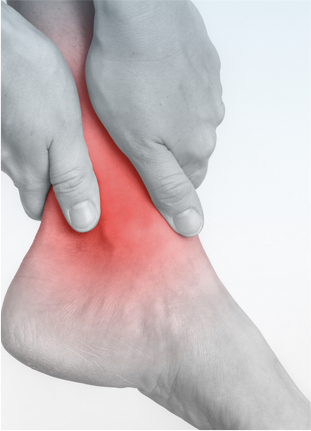Tendonitis

Your Tendonitis Specialist in Beverly Hills
Tendonitis often reveals itself over time after repeated engagement with activities that irritate the tendon. Because of its progressive nature, you may not even notice pain until you’re incapable of performing your daily routine. Yard work, carpentry, indoor chores, and sports like tennis, golf, skiing, and baseball may provoke tendonitis, especially in adults over age 40.
BookAn AppointmentTendonitis Basics

Tendons are the strong flexible cords that attach a muscle to the bone it inserts on. Tendonitis is inflammation around a tendon, typically caused by overuse. When over-exercised, tendons experience tearing and pulling apart of their collagen fibers. This results in swelling and pain.
Tendonitis may also be the result of muscular imbalances. If a singular muscle is pulling on a bone more than it is designed to, its tendon experiences excess stress. Foot and ankle muscular imbalances can come from abnormal bone structure, such as flat feet or high arches.
Occasionally, direct trauma or injury can induce tendonitis. Rarely, underlying medical conditions lead to generalized inflammation that manifests as tendonitis in the foot and ankle.
The primary symptom of tendonitis is pain.
This pain typically goes away with rest and increases during aggravating activities. Medical attention is necessary to make sure your tendonitis is not something more serious, like a bone fracture, ruptured tendon, or calcification. Managing tendonitis requires individualized treatment plans, orthotics, arch support, and even prescription braces.
Tendonitis Conditions We Treat
-
Extensor Tendonitis
Extensor tendons in your feet attach the muscles from the front of your legs to your toes. These vital tendons run across the top of the foot with little protection. Tendonitis of the extensors causes weakness and pain. We’ll use imaging to check for further complications, and devise a treatment plan that works for you.
-
Ankle
Ankle tendonitis may also be called peroneal tendonitis, and it affects the peroneal tendons that connect to the outside of your foot. An appointment may include a gait evaluation, to assess your walking patterns, as well as strength and mobility tests. With a proper treatment plan, your ankle tendonitis is less likely to turn into a torn tendon.
-
Achilles
Achilles tendonitis may affect the lower portion of the tendon that attaches to your heel bone (insertional Achilles tendonitis), or can involve the middle of the tendon (noninsertional Achilles tendonitis). Seeing a doctor for Achilles tendonitis is vital because worsening conditions may tear the tendon. Medication or surgery can be necessary for pain relief.
-
Causative Factors
Recurring tendonitis may be a sign of something more serious, which is where our team comes in. An abnormal foot structure, including flat feet or high arches, can both affect muscular balances. Certain chronic conditions cause bodily inflammation that may lead to tendonitis. Rheumatoid arthritis, gout, and more may need treatment.




Our Approach to Foot & Ankle Sprains
Extensive
No matter where your tendonitis is, our experienced team will pinpoint its exact cause.
Comfortable
Between our variety of non-invasive treatment methods, you’ll find your pain disappearing.
Individualized
Individualized plans may include treatments such as physical therapy, medications, prescription braces, pain relief injections, and surgery.
Why Choose Dr. Nik?
Tendonitis only gets worse with time, and it’s imperative to treat it immediately to prevent recurring injury. Dr. Nik’s publications, research, and lectures span every structure from the ankle down to the toes. This condition’s variety of causes can make it difficult to resolve, but our expertise will have you better in no time.
Meet Dr. Nik